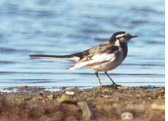Black-backed Wagtail
Alviso, California
18 December 2000
Joseph Morlan
Photos © 17 December 2000 Mike Rogers
 At 11 am today I met Mike
Mammoser and Tom Ryan to get into a closed section of the Cargill Salt Ponds where a Black-backed Wagtail had been
found by David McIntyre on the San Jose Christmas Bird Count. Mike had a permit to gain access to this area. John
Mariani and Jolene Lange were already there when we arrived. Soon John spotted the bird and we got distant scope
views. We elected to go around to the other side of the pond, where the light was better and where Mike and I eventually
got excellent fairly close scope views. We were able to watch the bird critically for 10-15 minutes before the
bird flew off to the northeast.
At 11 am today I met Mike
Mammoser and Tom Ryan to get into a closed section of the Cargill Salt Ponds where a Black-backed Wagtail had been
found by David McIntyre on the San Jose Christmas Bird Count. Mike had a permit to gain access to this area. John
Mariani and Jolene Lange were already there when we arrived. Soon John spotted the bird and we got distant scope
views. We elected to go around to the other side of the pond, where the light was better and where Mike and I eventually
got excellent fairly close scope views. We were able to watch the bird critically for 10-15 minutes before the
bird flew off to the northeast.
The following description is based on notes made immediately after the bird flew:
An obvious wagtail rather boldly patterned in black white and gray. It was larger than adjacent Least Sandpipers,
but smaller than adjacent Killdeer and Black Phoebe. It ran along the edge of the mud chasing brine flies in an
erratic, lurching manner often leaping into the air. Upon landing it would pump its long tail vigorously. One feature
of this individual is that it consistently drooped its left wing so that the tip of the wing was below the tail.
The forehead and throat where white framed by a broad black cap and a horseshoe shaped black bib. A black line
extended from the bill through the dark eye, expanding behind the eye and connecting to the broad black nape. Another
dark line extended from the upper corner of the bib to intersect at the point where the eyeline met the nape leaving
a sliver of white along the side of the neck on the right side. The left side was not seen well enough to determine
if this pattern was symmetric.
The black nape blended with the charcoal gray back which blended with a darker rump and uppertail coverts. The
gray was slightly mottled with black and strongly black on the scapulars. The underparts were white except for
a pale gray wash along the sides and flanks and a dark flank spot projecting down from the sides of the uppertail
coverts on each side.
The wings were the most striking feature of this bird. The coverts appeared to be entirely white, connecting
broadly to the white fringed tertials. The innermost tertials had black inner webs forming a slightly streaked
pattern. In flight, all the primaries and secondaries appeared to be entirely white forming huge white windows
which were extremely obvious. Only the tips of the primaries appeared to be dark.
The long tail was black except for white outer rectrices.
The bill was dark, thin and pointed, but thicker at the base and more tapered than would be typical of White
Wagtail (M. alba). The legs were also dark and fairly sturdy looking.
I judged this bird to be an adult male in basic plumage. The identification of individuals in this plumage is
quite straightforward. The combination of large white windows in the wings and dark back rule out the similar White
Wagtail.
Mike Mammoser drew a nice field sketch of the bird and Mike Rogers photographed it yesterday.
 At 11 am today I met Mike
Mammoser and Tom Ryan to get into a closed section of the Cargill Salt Ponds where a Black-backed Wagtail had been
found by David McIntyre on the San Jose Christmas Bird Count. Mike had a permit to gain access to this area. John
Mariani and Jolene Lange were already there when we arrived. Soon John spotted the bird and we got distant scope
views. We elected to go around to the other side of the pond, where the light was better and where Mike and I eventually
got excellent fairly close scope views. We were able to watch the bird critically for 10-15 minutes before the
bird flew off to the northeast.
At 11 am today I met Mike
Mammoser and Tom Ryan to get into a closed section of the Cargill Salt Ponds where a Black-backed Wagtail had been
found by David McIntyre on the San Jose Christmas Bird Count. Mike had a permit to gain access to this area. John
Mariani and Jolene Lange were already there when we arrived. Soon John spotted the bird and we got distant scope
views. We elected to go around to the other side of the pond, where the light was better and where Mike and I eventually
got excellent fairly close scope views. We were able to watch the bird critically for 10-15 minutes before the
bird flew off to the northeast.